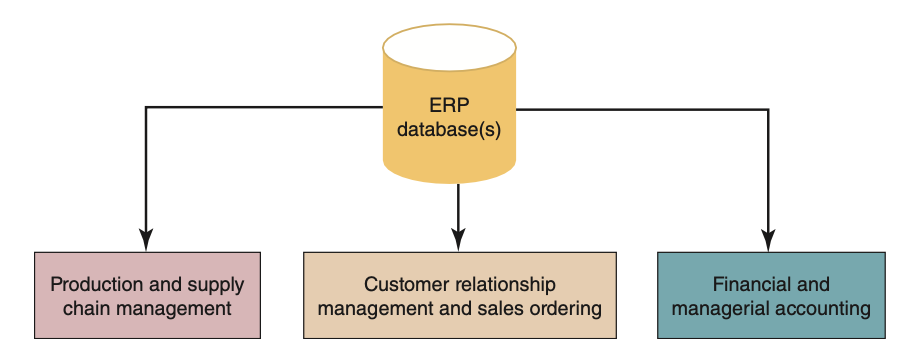Ch 10: Enterprise Systems
1/27
Earn XP
Description and Tags
ISDS 351
Name | Mastery | Learn | Test | Matching | Spaced |
|---|
No study sessions yet.
28 Terms
Transaction processing systems
capture and process the detailed data necessary to update records about the fundamental business operations of the organization AND supports routine operations associated with business processes, such as customer ordering and billing, shipping, employee payroll, purchasing, and accounting
Includes:
Order processing systems
Accounting systems
Purchasing systems
Batch processing system
A form of data processing whereby business transactions are accumulated over a period of time and are processed as a single unit or batch.
Appropriate and cost-effective appraoch.
*NOTE: Delay between event and processing of related transaction to update records.
Online transaction processing
A form of data processing where each transaction is processed immediately without the delay of accumulating transactions into a batch.
Data in an online system reflects current status
Many find OLTP enables faster, more efficient
service
TPSs for Entrepreneurs and Small-and Medium-Sized Enterprises
Many software packages provide integrated transaction processing system solutions for small- and medium-sized enterprises (SMEs)
Easy to install and operate with a low total cost
of ownership
Initial cost of a few hundred to a few thousand
dollars
Transaction processing cycle
The process of data collection, data editing, data correction, data processing, data storage, and document production.

Data collection
Capturing and gathering all data necessary to complete the processing of transactions.
Done manually or automated via special input devices.
Streaming
A form of data collection, where data is available through a continuous feed.
Is the best choice when organizations are using the data to become more agile, innovative, and responsive to threats.
Source data automation
Capturing data at its source and recording it accurately in a timely fashion, with minimal manual effort and in an electronic or digital form so that it can be directly entered into the computer.
Ex) Scanner at the register.
Data editing
Checking data for validity and completeness to detect any problems.
Quantity and cost data must be numeric
Names must be alphabetic
Codes associated with an individual transaction
are edited against a database containing valid
codes
Data correction
Reentering data that was not typed or scanned properly.
Should specify the problem so proper
corrections can be made.
Systems should provide error messages
that alert those responsible for editing the
data.
Data processing
Performing calculations and other data transformations related to business transactions.
Classifying data
Sorting data into categories
Performing calculations
Summarizing results
Storing data in the organization’s database for
further processing
Data storage
Updating one or more databases with new transactions.
Document production
Generating output records, documents, and reports.
These can be hard-copy paper reports or displays on computer screens.
Enterprise system
A system central to the organization that ensures information can be shared with authorized users across all business functions and at all levels of management to support the running and managing of a business.
Enterprise resource planning (ERP)
Set of integrated programs that manage a company’s vital business operations for an entire organization
ERP systems evolved from materials
requirement planning systems (MRP)
developed in the 1970s

Advantages of ERP
Improved access to quality data for operational decision making
AI-generated insights and the human-machine learning partnership
Elimination of costly, inflexible legacy systems
Improvement of work processes
Opportunity to upgrade and standardize technology infrastructure
Best practices
The most efficient and effective ways to complete a business process.
Supply chain management
A system that includes planning, executing, and controlling all activities involved in raw material sourcing and procurement, the conversion of raw materials to finished products, and the warehousing and delivery of finished products to customers.
Process for developing a production plan
Sales forecasting
Sales and operations plan (S&OP)
Demand management
Detailed scheduling
Materials requirement planning (MRP)
Purchasing
Production
Sales ordering
Customer relationship management (CRM) system
A system that helps a company manage all aspects of customer encounters, including marketing, sales, distribution, accounting, and customer service.
Goal: To understand and anticipate the needs of current and potential customers to increase customer retention and loyalty while optimizing the way that products and services are sold.
Key features of a CRM system
Contact management
Sales management
Customer support
Marketing automation
Analysis
Social networking
Access by mobile devices
Import contact data
Product lifecycle management (PLM)
An enterprise business strategy that creates a common repository of product information and processes to support the collaborative creation, management, dissemination, and use of product and packaging definition information.
Product lifecycle management software
Software that provides a means for managing the data and processes associated with the various phases of the product lifecycle, including sales and marketing, research and development, concept development, product design, prototyping and testing, process design, production and assembly, delivery and product installation, service and support, and product retirement and replacement.
Computer-aided design (CAD)
The use of software to assist in the creation, analysis, and modification of the design of a component or product.
Computer-aided engineering (CAE)
The use of software to analyze the robustness and performance of components and assemblies.
Computer-aided manufacturing (CAM)
The use of software to control machine tools and related machinery in the manufacture of components and products.
Discrete manufacturing
The production of distinct items such as autos, airplanes, furniture, or toys that can be decomposed into their basic components.
Process manufacturing
The production of products—such as soda, laundry detergent, gasoline, and pharmaceutical drugs—that are the result of a chemical process; these products cannot be easily decomposed into their basic components.